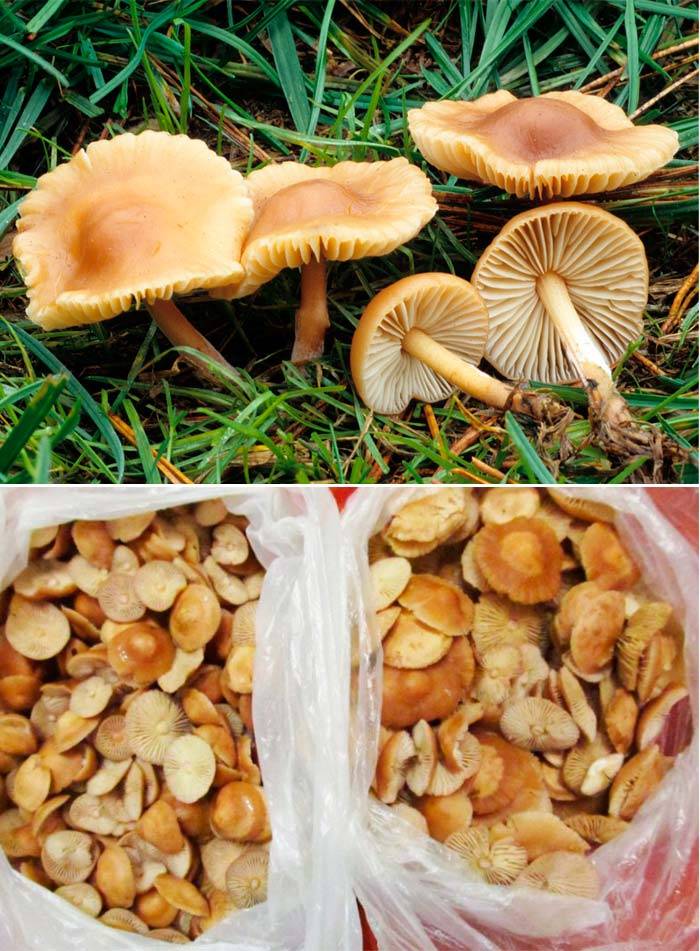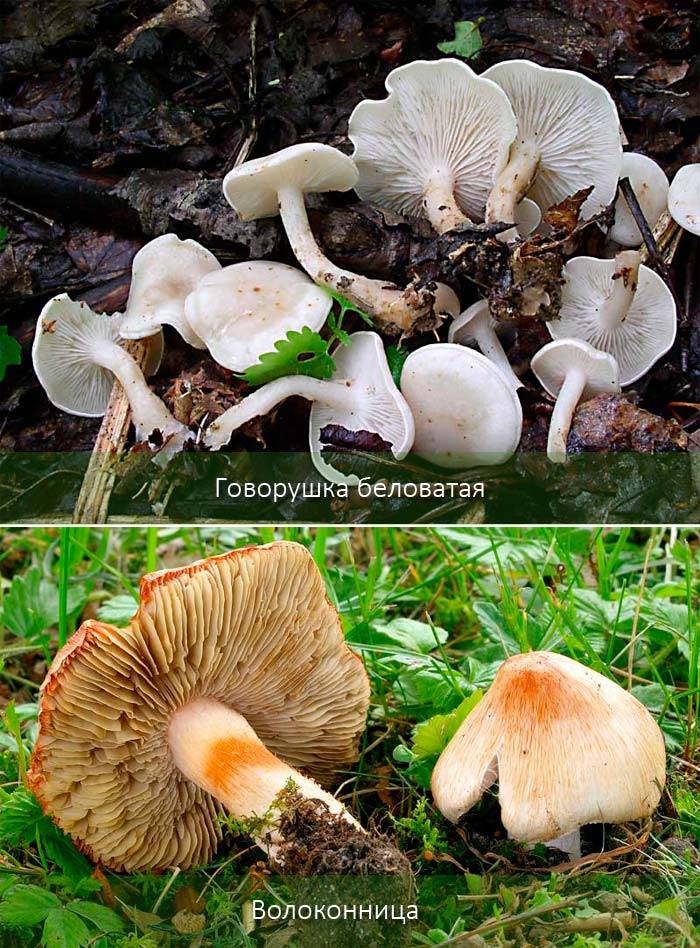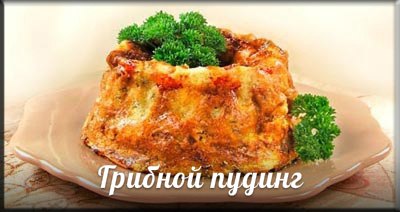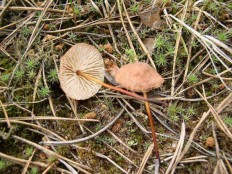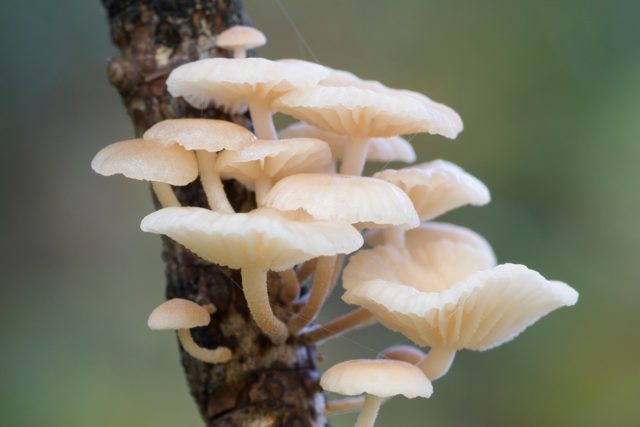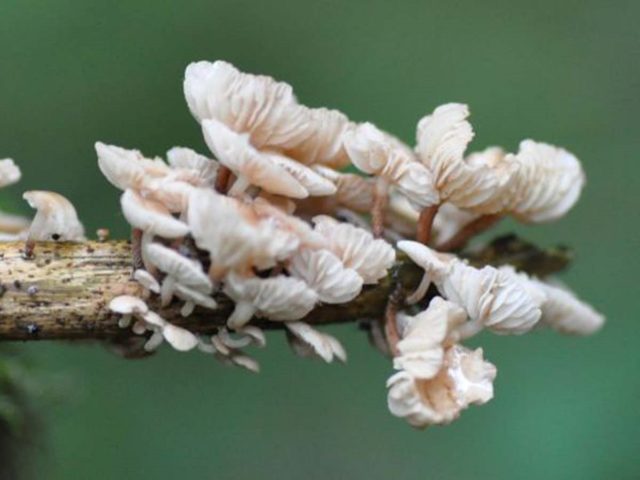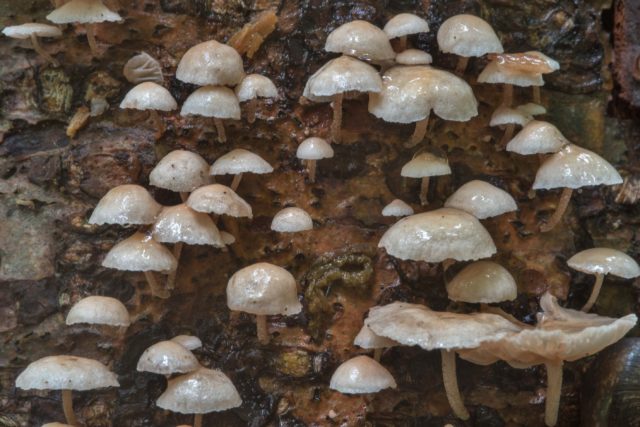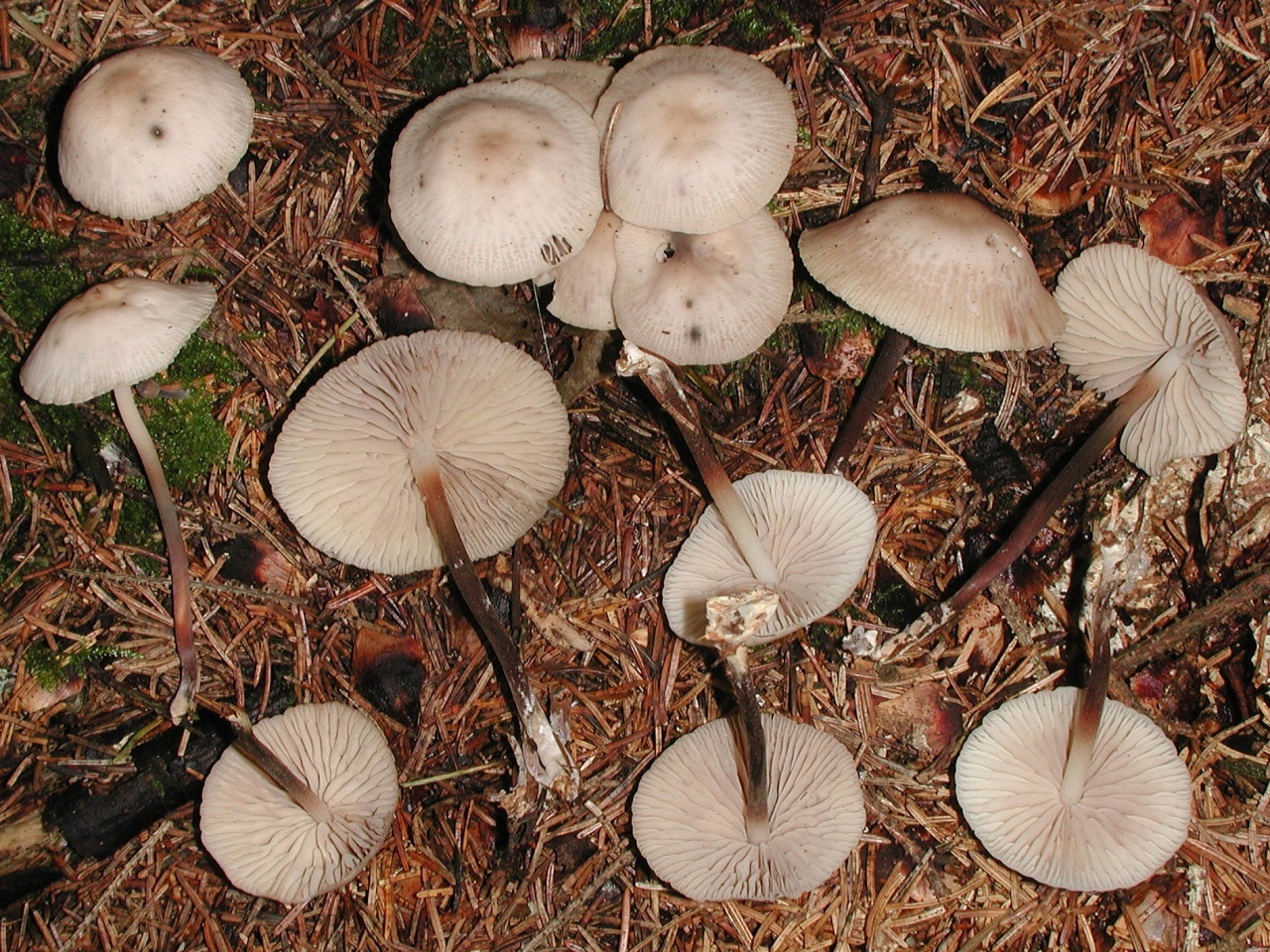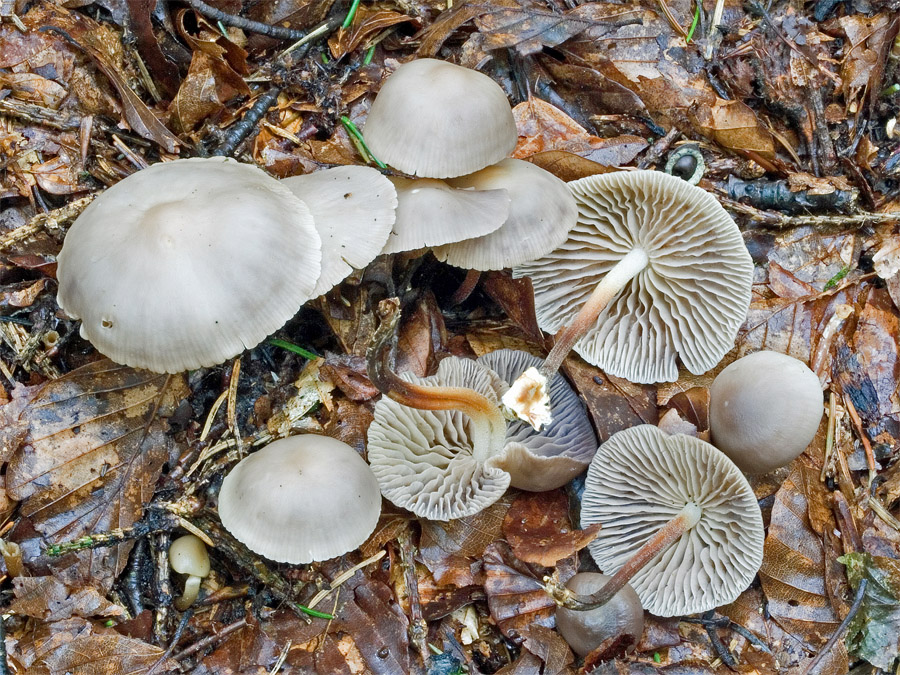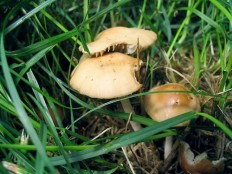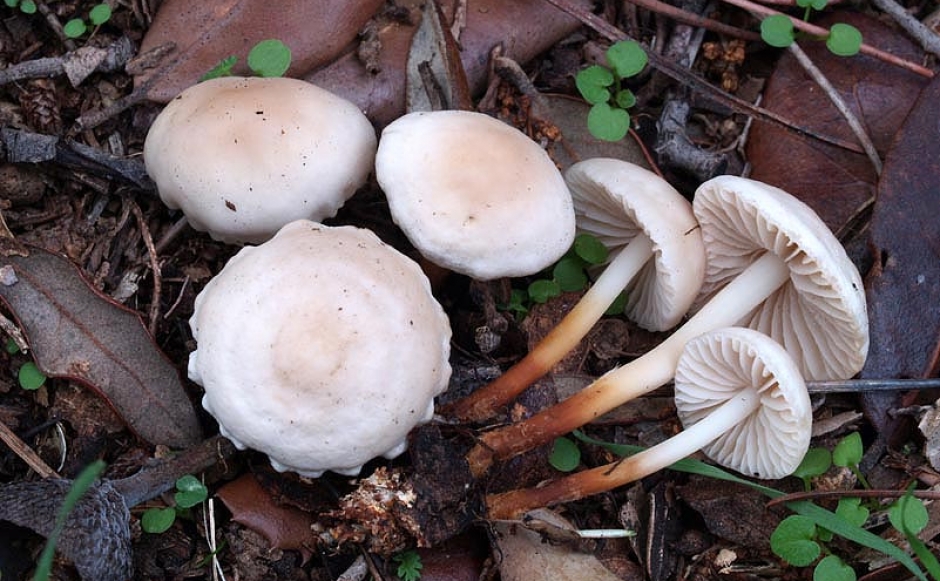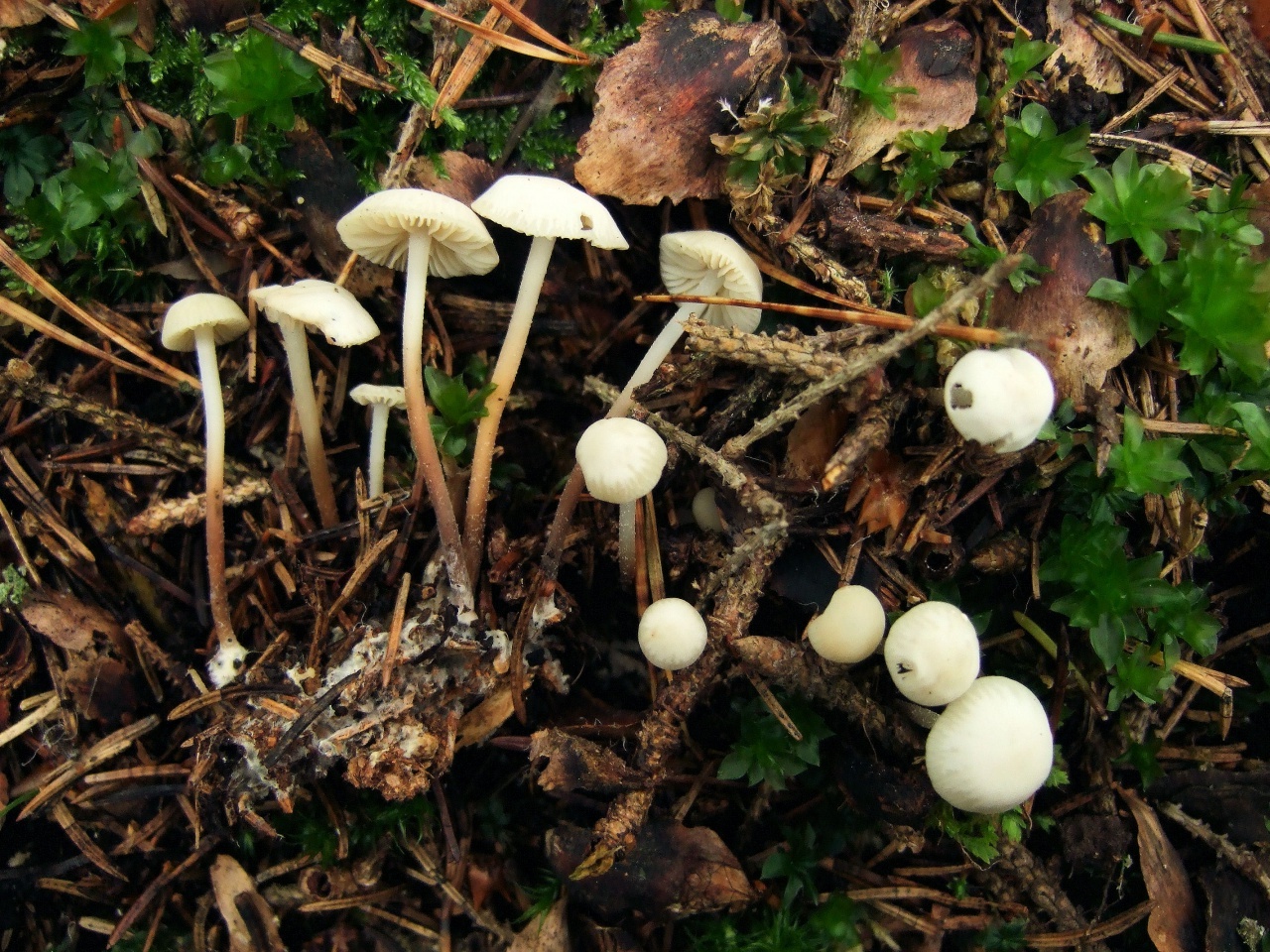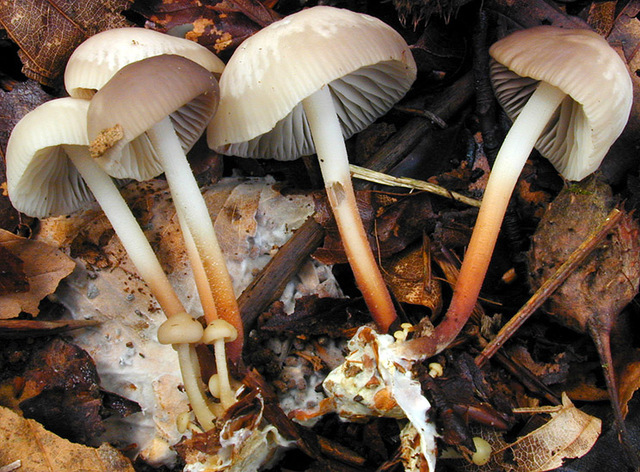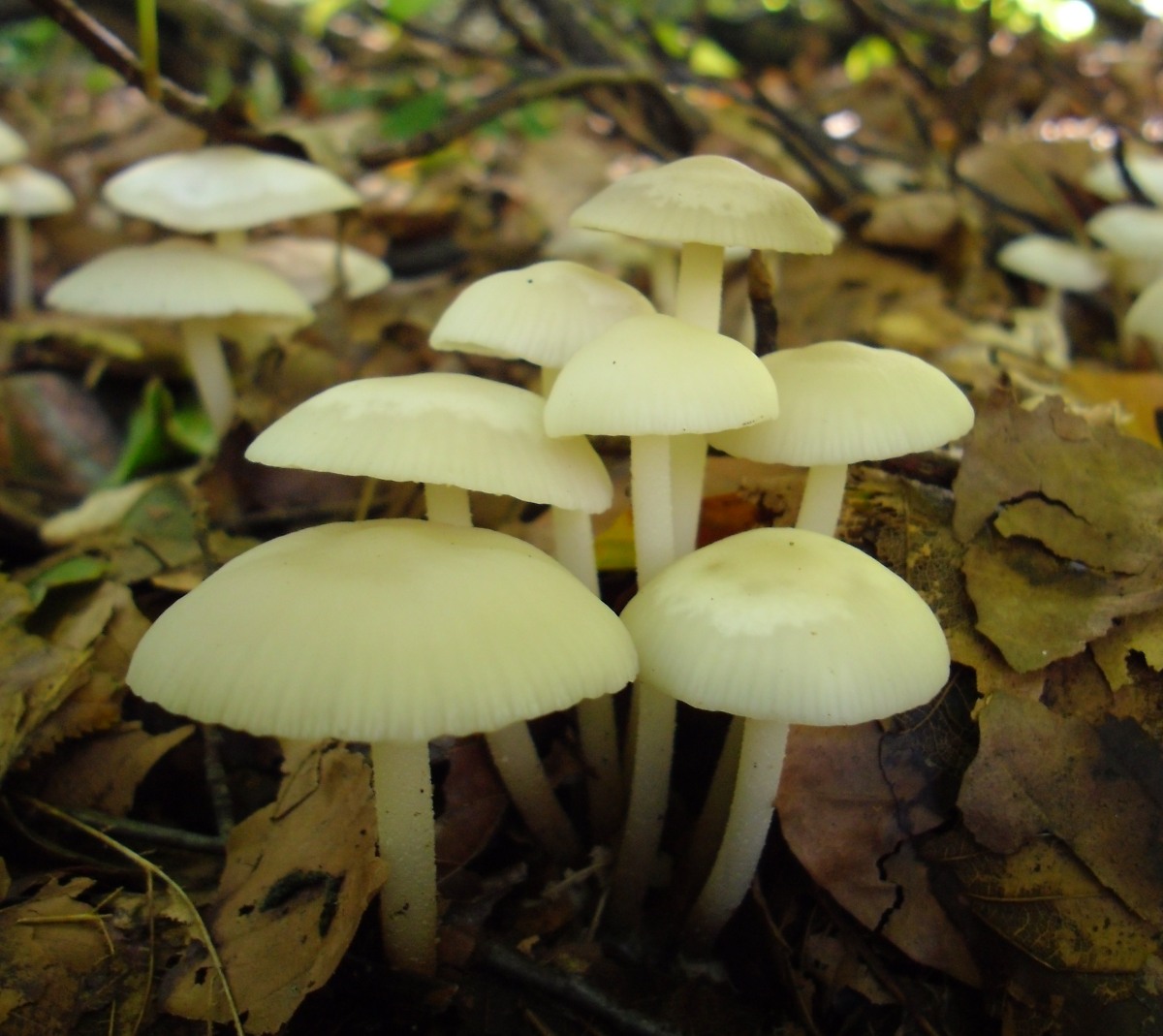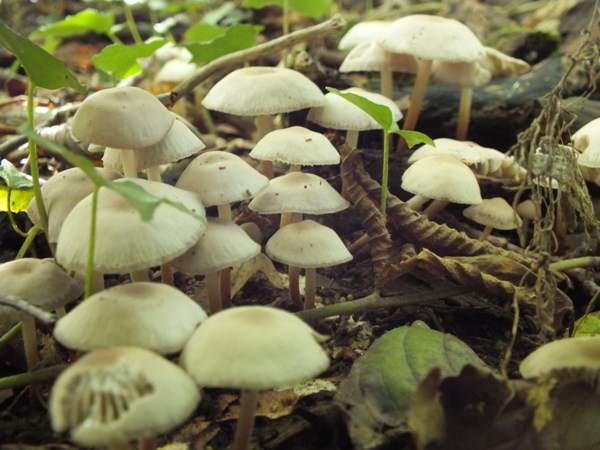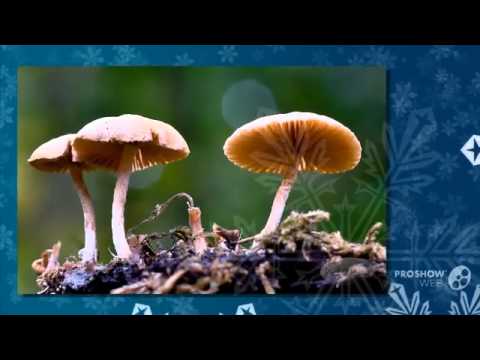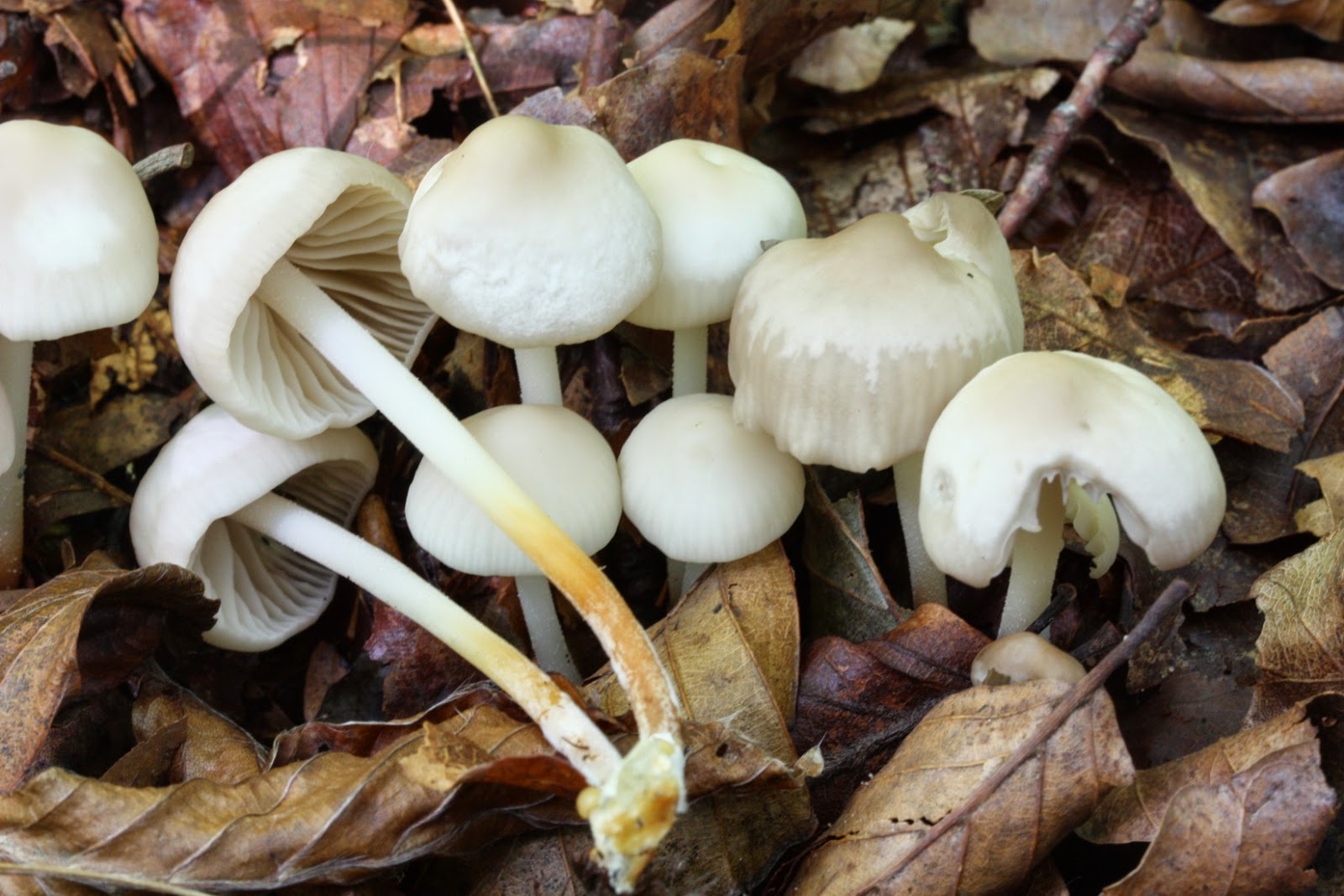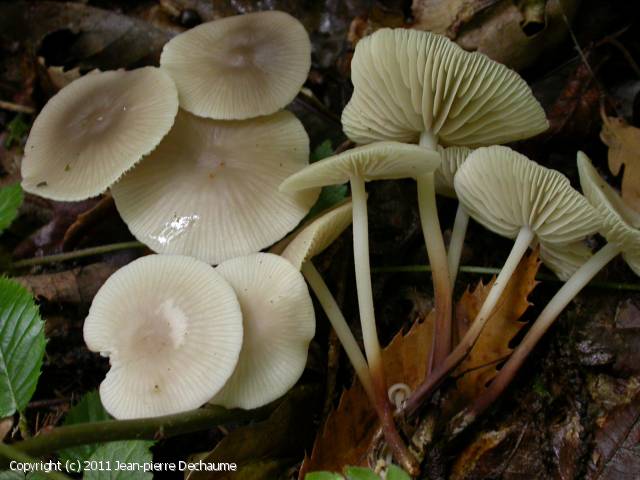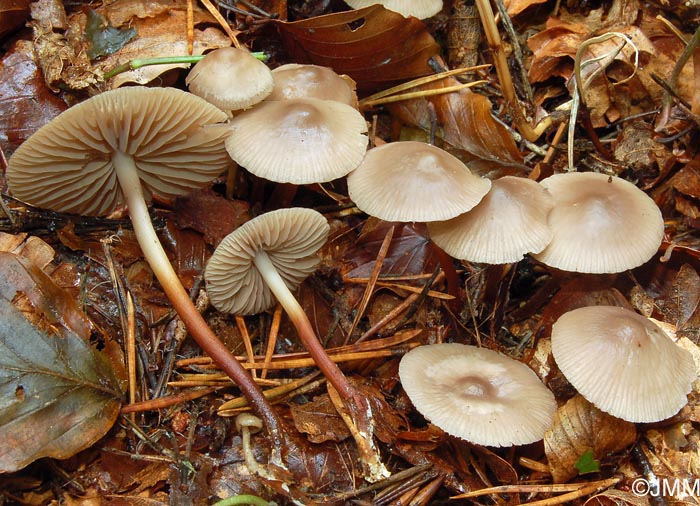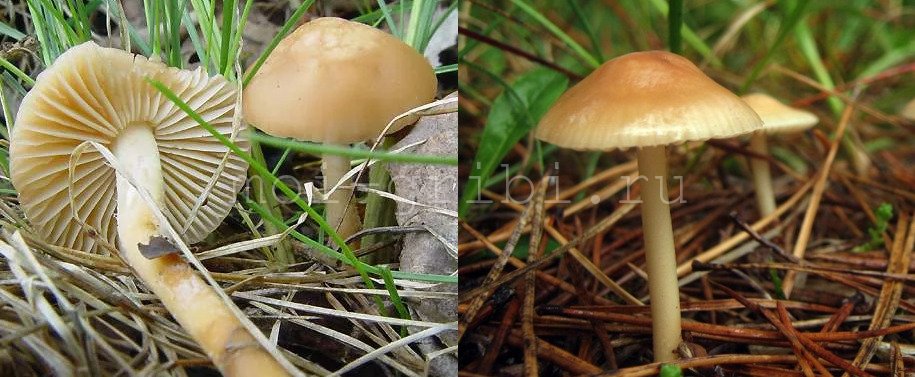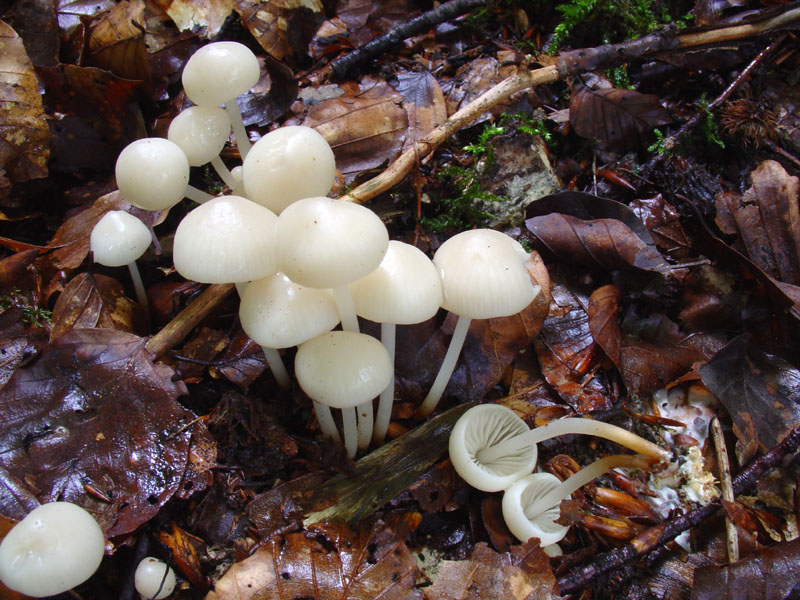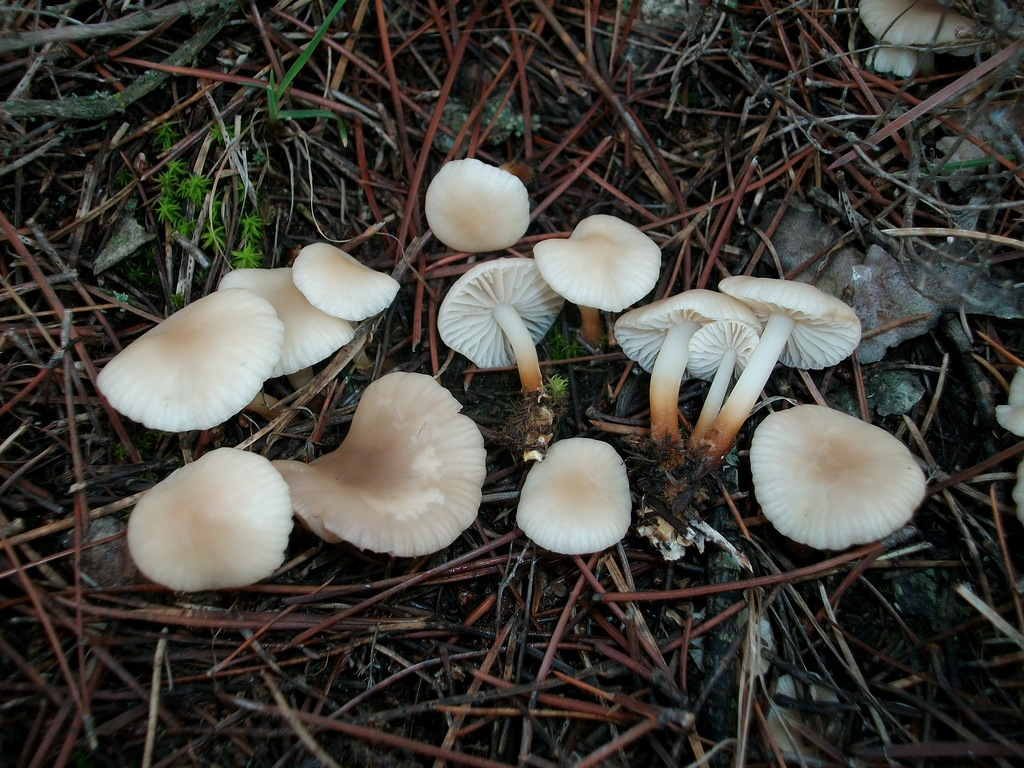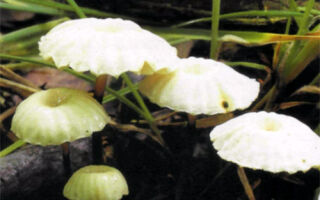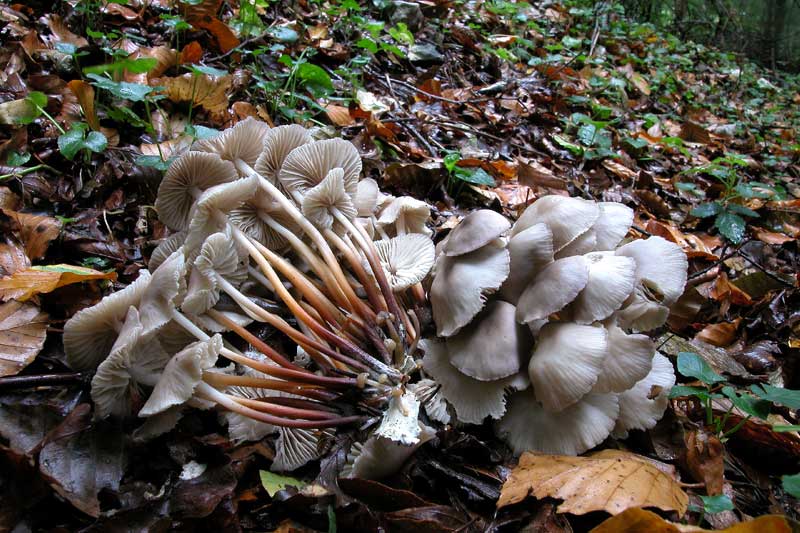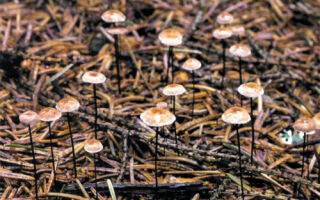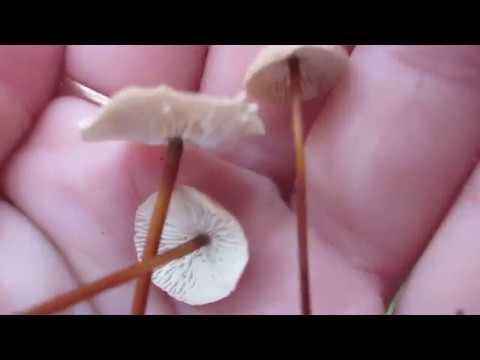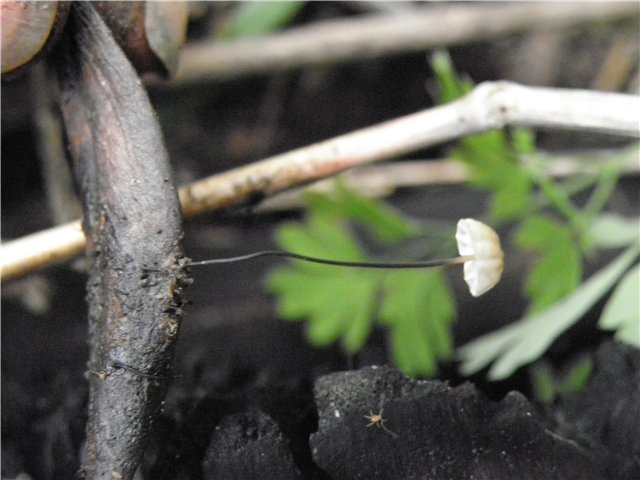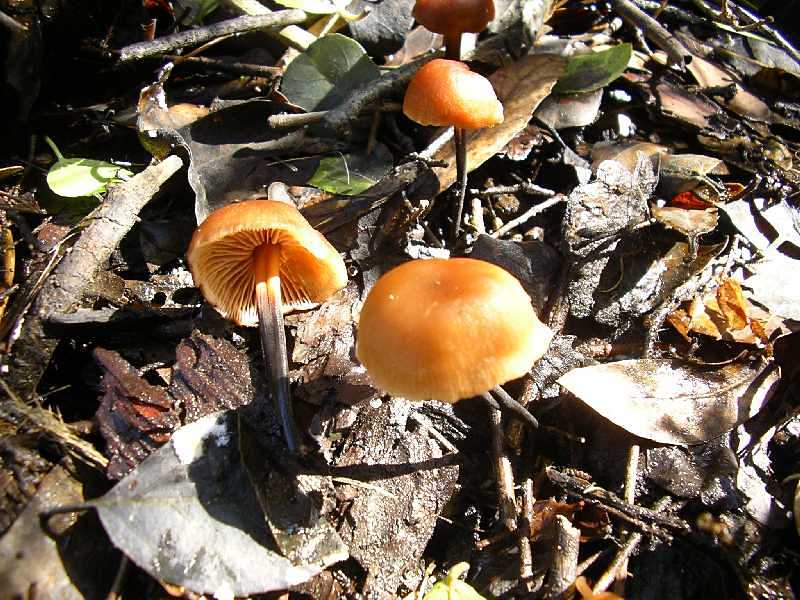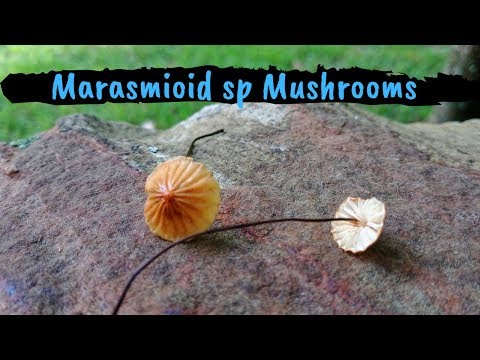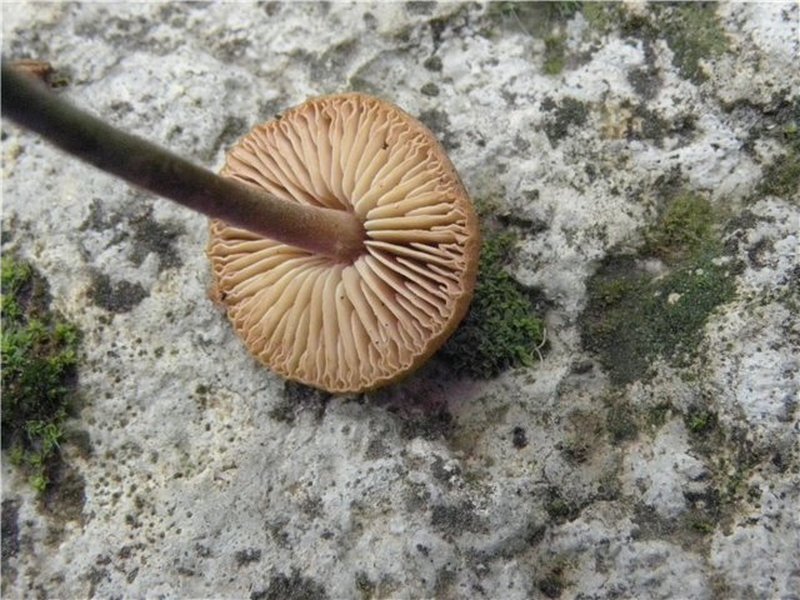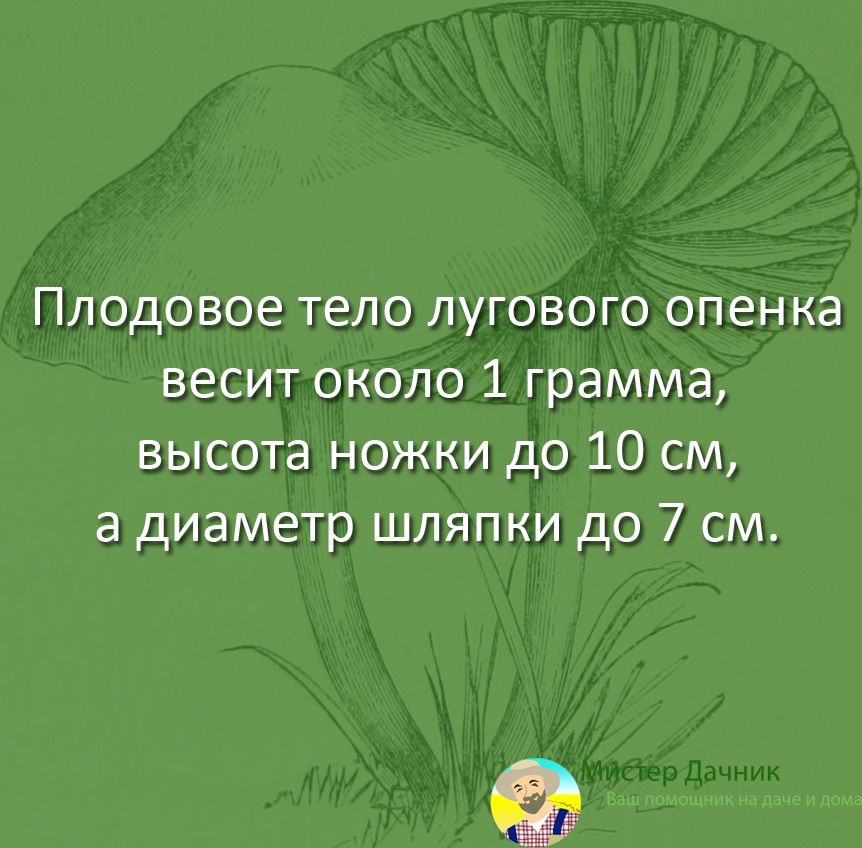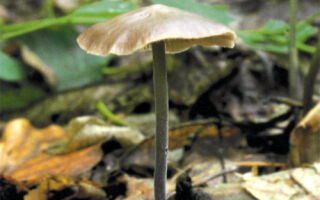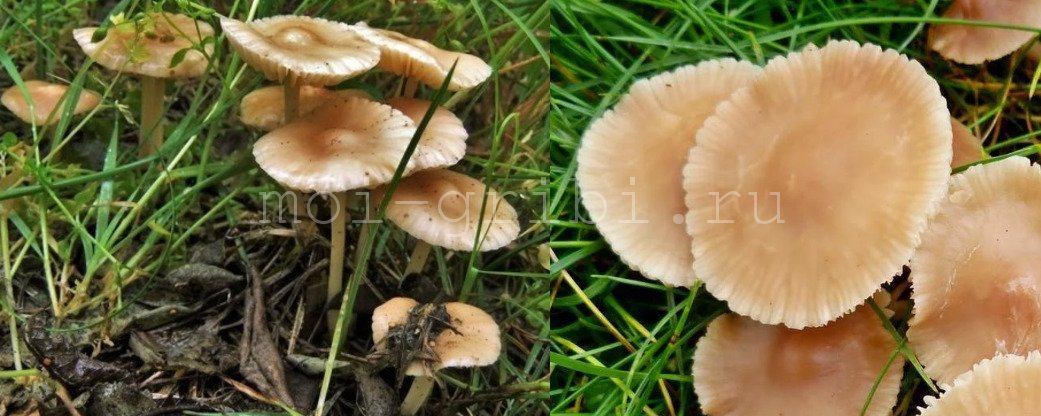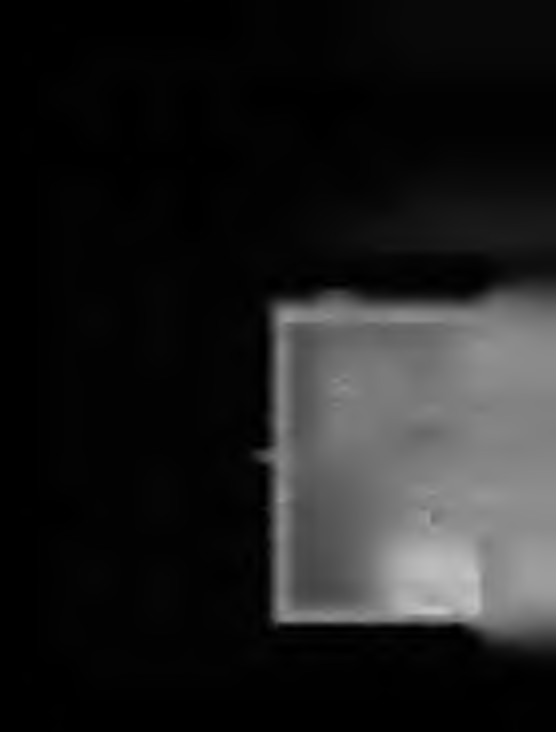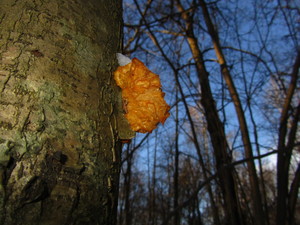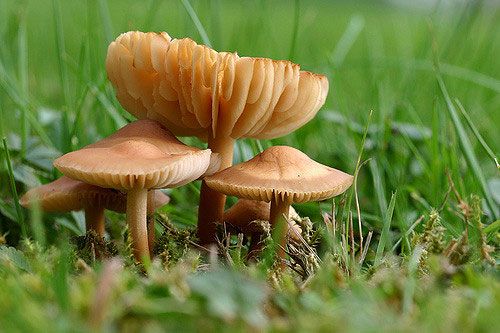Wheeled reed, Marasmius rotula
Hat: Very small, 0.5 - 1.5 cm in diameter. The shape is from hemispherical in youth to half-spread, with a narrow and deep depression in the central part. The surface is radially wavy, with deep depressions and rises - it may seem that there is no pulp at all, and the surface of the cap is a single whole with rare plates. Color - from pure white in young mushrooms to grayish yellow in older or dry specimens. The pulp is very thin, with a subtle, pungent aroma.
Hymenophore: Very rare, white, adherent to the collar framing the leg - collarium.
Spore powder: White.
Leg: Very thin (no more than 1.5 mm thick), rather long (3-8 cm), dark brown or black, darker in the lower part.
Spreading: The wheatear grows in damp places on the remains of trees, twigs, and also on deciduous and coniferous litter. Marasmius rotula occurs frequently and in large groups approximately from July to mid-October. Due to natural reasons, it is hardly noticeable.
Similar species: The literature indicates the same “wheel-like”, but not so white Marasmius bulliardii, M. curreyi, etc. as twin mushrooms for Marasmius rotula. Again, due to natural reasons, errors are not only not excluded here, but more than likely.
Edibility: The wheel-shaped insect is so small that it can hardly even contain poison.
Author's notes: In my understanding, non-fungi, garlic and other marasmius are rather not mushrooms, but details of some kind of “forest mechanism”. Gears, wheels, links are scattered as if at random, but the system works, the system does not give obvious failures. Performs its task, whatever it may be. By the way, there is still some task that is different from maintaining the system: it is no coincidence that some mushrooms carry a decorative load, while others - pure functionality and nothing more. Even mycenae, even though they cannot be seen without glasses, are presented in color, and sometimes even decorated with some strange antennae. All this is clearly not without reason, and what is the funniest thing is that the simplest and most functional mushroom tells us. This is how the system exposes its own structure to an attentive observer.
“You can't get very far on these wheels. "With age, our thumbnail somehow goes down, dull, and it becomes completely indistinguishable from his many fellow. Apart from the well-known resemblance to a wheel, it is given out by not quite microscopic dimensions and a pronounced collarium at the place of attachment of the plates. Although, of course, the mature Marasmius rotula cannot be called a beautiful mushroom.
Wheeled Nebnichnik - description, poisonousness of the mushroom
Wheeled non-fungus is an inedible species of mushrooms belonging to the non-fungus family. The Latin name for this species is Marasmius rotula.
Description
The cap of representatives of this type of mushroom is rather modest in size and reaches only 10 -15 mm in diameter. At the beginning of development, the shape of this part of the fungus is spherical, with growth it straightens and becomes more extended. In the central part of the cap, you can see a characteristic, albeit narrow, but rather deep depression. The surface of the cap itself has a fibrous structure, which makes it possible to clearly see all its details (tubercles, depressions). At the first glance at the mushroom, it may seem that the cap of the non-pot has absolutely no pulp, nevertheless, the latter is very thin and almost visually inseparable from the lamellar body. At the beginning of growth, the cap of the specimens is very light, with the growth of the fungus it acquires a gray-yellow color. The aroma of the pulp, although weak, is quite sharp.
The white plates are located with small gaps, most often they grow to the characteristic collar bordering the mushroom stalk. The spore powder has the same color as the lamellar body.
The Negnichnik has a rather thin leg, the length of which reaches 80 mm. This part of the mushroom is dark in color, almost black at the base.
Similarities with other species
Often this type of inedible mushroom is confused with Bullar's non-fungus, which has almost the same appearance (white color of the fruiting body, and a characteristic wheel-like shape). Nevertheless, the main difference between the wheel-like non-nipple is the presence of a pronounced collar located in the upper part of the leg, to which the plates descending from the lamellar body are attached.
Edibility
According to the available information, the wheel-shaped nonnium does not belong to the poisonous species of mushrooms, however, it is also not used in cooking, which is due to its very modest size.
Features of the view
The main feature of this type of mushroom is that during dry periods the non-fungi dry out almost completely, however, this does not mean their complete death. With the onset of the rainy season, the representatives of this species are completely restored to their previous form, and they begin to bear fruit and grow again.
I would like to draw your attention to the fact that this type of mushroom, in fact, has no practical value. The only thing that scientists stand out is an enzyme like MroAPO contained in this mushroom, which is a kind of biosensor used for the analysis of aromatic substances.
Other non-burners
The Marasmius family of mushrooms includes about 500 different species, and only a small part of them are edible. The rest of the species, as a rule, are not collected, often the reason for this is the unattractive appearance of the mushrooms and their modest size.
Such a species as the most delicate non-pot is a modest-sized fungus that does not have any nutritional value. At the beginning of development, specimens of this species have a hemispherical cap, which straightens out with the growth of the fungus. In adult mushrooms, in the center of the cap there is a small tubercle of a characteristic dark brick color. The body of the cap is rather thin, the edge is wavy with rare radial folds. At the beginning of development, the cap is white; it darkens with the growth of mushrooms. The leg, like the cap, is of a deep brown color. The peak of fruiting of this type of non-nippers is from mid-summer to mid-autumn. Most often, these mushrooms are found in mixed forests.
Spherical refractory: photo and description
| Name: | Spherical |
| Latin name: | Marasmius wynnei |
| Type of: | Edible |
| Synonyms: | Marasmius wynnei, Chamaeceras wynnei, Chamaeceras wynneae |
| Systematics: |
|
Spherical Negnium is an edible member of the Negnium family. The Latin name for this specimen is Marasmius wynnei.
Dry (Marasmius siccus)

Current title
| Index Fungorum | Marasmius siccus (Schwein.) Fr. | |
| MycoBank | Marasmius siccus (Schweinitz) Fries |
Systematic position
Etymology of the species epithet
Synonyms
- Agaricus siccus Schwein., Schriften der Naturforschenden Gesellschaft zu Leipzig 1:84 (1822)
- Chamaeceras siccus (Schwein.) Kuntze, Revisio generum plantarum 3: 457 (1898)
Habit
Fruit body: Cap and stem (agaricoid)
Hymenophore: Lamellar (including folded or with rudimentary plates)
Hat
The cap is 0.8 - 1.5 cm, radially ribbed-furrowed, bell-shaped, convex, almost spread, matte, orange-brown to red-brown.
The plates are almost free, rare, light, cream.
Leg
Leg 4 - 6 × 0.1 cm, shiny, rigid, like a string, black-brown, white-pubescent at the top, at the base with a rosette of long dirty walnut filaments of mycelium.
Microscopy
Spores 15 - 23.5 × (2.5) 3.0 - 4.5 (5.0) µm, narrow-clavate, clavate, fusiform, sometimes slightly curved.
Basidia 20 - 40 × 5.0 - 9.0 μm, clavate, 4-spore.
Ecology and distribution
Grows in groups on dried leaves, needles, small twigs.
Fruiting
The divisions correspond to the decades of the month.
Nutritional properties
Related materials
- Vasilyeva L.N.- L .: "Science", 1973. - 331 p. - P. 137
- Antonin V., Noordeloos N. E. A monograph of Marasmius, Collybia and related genera in Europe. Part 1: Marasmius, Setulipes and Marasmiellus. - Eching: IHW-VERLAG, (Libri botanici, Vol. 8), 1993 .-- 229 p. - P. 81.
Link to this page for prints
Ageev D.V., Bulonkova T.M. Dry Negnium (Marasmius siccus) - Mushrooms of Siberia URL: https://mycology.su/marasmius-siccus.html (date accessed: 26.01.2020).
Share link
Discussions

| 3066 | |
| Dmitry Ageev | |
| 2013-09-07T02: 26: 49 | |
| Last modified date: | 2018-11-15T10: 44: 31 (Dmitry Ageev) |
OOO OOO OOO OOO OOO OOO OOO OOO OOO OOO OOO OOO OOO OOO OOO OOO OOO OOO OOO OOO OOO OOO OOO OOO OOO OOO OOO OOO OOO OOO OOO OOO OOO OOO OOO OOO OOO OOO OOO OOO OOO OOO OOO OOO OOO OOO OOO OOO OOO OOO OOO OOO OOO OOO OOO OOO OOO OOO OOO OOO OOO OOO OOO OOO OOO OOO OOO OOO OOO OOO OOO OOO OOO OOO OOO OOO OOO OOO OOO OOO OOO OOO OOO OOO OOO OOO OOO OOO OOO OOO OOO OOO OOO OOO OOO OOO OOO OOO OOO OOO OOO OOO OOO OOO OOO OOO OOO OOO OOO OOO OOO OOO OOO OOO OOO OOO OOO OOO OOOì
Age restrictions
Federal Law of the Russian Federation of December 29, 2010 No. 436-FZ "On the Protection of Children from Information Harmful to Their Health and Development."
Control
2010–2019 All rights reserved.
Definitioner
Lat. Basidia. A specialized structure of sexual reproduction in fungi, inherent only in Basidiomycetes. Basidia are terminal (end) elements of hyphae of various shapes and sizes, on which spores develop exogenously (outside).
Basidia are diverse in structure and method of attachment to hyphae.
According to the position relative to the axis of the hypha, to which they are attached, three types of basidia are distinguished:
Apical basidia are formed from the terminal cell of the hypha and are located parallel to its axis.
Pleurobasidia are formed from lateral processes and are located perpendicular to the axis of the hypha, which continues to grow and can form new processes with basidia.
Subasidia are formed from a lateral process, turned perpendicular to the axis of the hypha, which, after the formation of one basidium, stops its growth.
Based on morphology:
Holobasidia - unicellular basidia, not divided by septa (see Fig. A, D.).
Phragmobasidia are divided by transverse or vertical septa, usually into four cells (see Fig. B, C).
By type of development:
Heterobasidia consists of two parts - hypobasidia and epibasidia developing from it, with or without partitions (see Fig. C, B) (see Fig. D).
Homobasidia is not divided into hypo- and epibasidia and in all cases is considered holobasidia (Fig. A).
Basidia is the place of karyogamy, meiosis and the formation of basidiospores. Homobasidia, as a rule, is not functionally divided, and meiosis follows karyogamy in it. However, basidia can be divided into probasidia - the site of karyogamy and metabasidia - the site of meiosis. Probasidium is often a dormant spore, for example in rust fungi. In such cases, probazidia grows with metabasidia, in which meiosis occurs and on which basidiospores are formed (see Fig. E).
Crinipellis scabella (Crinipellis scabella)
Synonyms:
- Agaricus scabellus
- Marasmius caulicinalis var. scabellus
- Marasmius scabellus
- Agaricus stipitarius
- Agaricus stipitarius var. graminealis
- Agaricus stipitarius var. corticalis
- Marasmius gramineus
- Marasmius epichlo
Description
Hat: 0.5 - 1.5 centimeters in diameter. Initially, it is a convex bell, with growth the cap becomes flat, first with a small central tubercle, then, with age, with a small depression in the center. The surface of the cap is radially wrinkled, light beige, beige, fibrous, with brownish, reddish-brown longitudinal scales, which form dark reddish-brown concentric rings. The color fades over time, becoming uniform, but the center is always darker.
Plates: adherent with a notch, whitish, creamy-whitish, rare, wide.
Leg: cylindrical, central, 2 - 5 centimeters high, thin, 0.1 to 0.3 cm in diameter. Very fibrous, straight or twisted, and feels sluggish to the touch. The color is reddish-brownish, light at the top, darker at the bottom. Covered with dark brown or brownish-reddish, darker than the cap, thin hairs.
Flesh: thin, fragile, white.
Smell and taste: not pronounced, sometimes referred to as "weak mushroom".
Spore powder: whitish Spores: 6-11 x 4-8 microns, ellipsoidal, smooth, non-amyloid, whitish.
Ecology
Crinipellis rough - saprophyte. Grows on wood, prefers small pieces, chips, small twigs, bark. It can also grow on the herbaceous debris of various plants or other fungi. Of the herbaceous, he prefers cereals.
Season and distribution
The fungus is found quite abundantly from late spring to autumn; it is widespread in America, Europe, Asia, and possibly on other continents.It can be found in large forest clearings, forest edges, meadows and pastures, where it grows in large groups.
Etymology of the name
Crinipellis refers to the fibrous, woolly cuticle and means hair. "Scabella" means a straight stick hinting at the leg.
Similar species
Crinipellis zonata is distinguished by a sharper central tubercle and a large number of pronounced thin concentric rings on the cap.
Crinipellis corticalis - the hat is more fibrous and more pubescent. Microscopically: almond-shaped spores.
Marasmius cohaerens - more creamy and softer colors, the cap is wrinkled, but without fibers and with a very dark center, without concentric zones.
Photo: Andrey.
Common garlic - a mushroom with a garlic smell
Common garlic is a mushroom of the family Negniychnikovye, genus Garlic. It is an edible mushroom. It is also called ordinary non-nippers.
The Latin name for the mushroom is Marasmius scorodonius.
Description of common garlic
Common garlic hat convex shape, over time it becomes flat-outstretched. Its diameter is small - from 1 to 3 centimeters. The color of the cap is yellow-brown, slightly buffy, and eventually becomes fawn. It is lighter on the edges. The hat is small and dry, the skin is dense and rough.
There are small grooves along the edges of the cap. In fully ripe garlic plants, the caps become bell-shaped with very thin edges. Over time, the cap becomes wider, and a small depression appears in the central part. When it rains, the hat absorbs moisture and becomes meaty-red, and in dry weather, its color fades.
The pulp is pale with a pronounced smell of garlic, which, when dried, becomes even stronger, which is why the name of the mushroom came about. The plates are wavy, convex, of different lengths, located far from each other. They grow to the base of the stem. Their color is whitish or pale red. Spore white powder.
The leg is reddish-brown in color, while its lower part is lighter. The surface of the leg is shiny and cartilaginous. It is hollow inside.
Distribution of common garlic
These mushrooms are found in various types of forests. They grow in forest floor, choosing dry places. Common garlic plants prefer clay and sandy soils. Most often they are found in large groups. Fruiting from July to October.
Fungal colonies are easily identified by the smell of garlic emitted by the mushroom bodies. On cloudy and rainy days, this smell becomes stronger.
Edibility of common garlic
These are edible mushrooms. They can be used boiled, fried, pickled and dried. Ordinary garlic plants are also well suited for making hot spices. After boiling, the characteristic garlic smell disappears, but when dried, on the contrary, it intensifies.
The similarity of common garlic with other mushrooms
Common garlic can be confused with meadow grass, which grows on branches and fallen needles, but does not smell like garlic.
Other mushrooms of this genus
The blood-headed firebrand is one of the rarest mushrooms in the world. Its peculiarity is that it glows in the dark. There is very little information about these mushrooms.
Bloodheads have a graceful appearance - their legs are very thin, and their domed caps are deep red in color. There are longitudinal stripes on the top of the caps, which are located symmetrically in relation to each other. The leg is darker. These mushrooms grow on fallen or old trees. There is no information about their toxicity, but they are classified as inedible species.
The stamen grass is an inedible mushroom. His hat is initially convex, but with age it becomes prostrate.
The stamen grass bears fruit from June to September.These mushrooms settle on small branches of fallen trees. They are often found among the sand dunes, in the wastelands.
They grow in large colonies, which consist of several dozen specimens.
There is no information about the toxicity of these mushrooms, it is possible that they do not contain toxic substances, but they are classified as inedible species and are not eaten due to the unpleasant smell of the pulp.
Negniichnik dry: photo and description
| Name: | Dry |
| Latin name: | Marasmius siccus |
| Type of: | Inedible |
| Synonyms: | Agaricus siccus, Chamaeceras siccus |
| Systematics: |
|
Dry Negniychnikov is a member of the Negniychnikov family. The Latin name for this species is Marasmius siccus, which also has a number of synonyms: Chamaeceras siccus and Agaricus siccus.
What does a dry non-drip look like?
The mushroom is shaped like an umbrella
The fruit body of the specimen in question consists of a small cap and a long stem. The pulp is very thin, has a slight odor and a bitter taste.
Description of the hat
Always grows in large groups
At the initial stage of ripening, the cap of the dry non-pot is bell-shaped or cushion-shaped; as it grows, it acquires an almost prostrate shape. In its central part, there may be a tubercle or a pronounced flat zone, less often - a small depression. The cap is small in size, it is only 0.5 to 3 cm. It is painted in bright red-brown or orange-brown shades, it fade in old mushrooms. In the central part of the cap, the saturated color lasts longer than along its edges. The surface is smooth, dry and matt with a pronounced radial groove.
On the inner side of the cap, there are rare, almost free, or adhered toothed plates. Painted in light cream or pale yellow tones. Spores are cylindrical or fusiform, smooth, sometimes slightly curved.
Leg description
Grows throughout the summer and in the first half of autumn
For such a small cap, the leg of a dry non-nylon is considered to be rather long, the height of which ranges from 2.5 to 7 cm. Its maximum thickness in diameter reaches about 1.5 mm. It is characterized as central, rigid, straight or slightly curved, even, without bulging. The surface is shiny, smooth to the touch. The upper part of the leg is colored white or light yellow, while the lower part is dominated by dark brown or black shades. At the base there is a white felt mycelium.
Where and how it grows
The optimal time for growing is the period from June to September. Most often, dry non-nipple dwells in deciduous forests on shallow deadwood or leaf litter, less often on needles. Widely distributed in Asia, America and Europe, including Russia, Belarus and Ukraine. This species does not tend to grow one at a time, usually occurs in large groups.
Is the mushroom edible or not
Dry non-fungus belongs to the category of inedible mushrooms. Due to the small size of the fruit bodies, it has no nutritional value and is not suitable for human consumption.
Doubles and their differences
According to its external features, dry non-nipple plant is similar to the following gifts of the forest:
- Blood-headed firebrand. It is an inedible and rare species that has the ability to glow at night. You can recognize the double by a small domed red hat and a rather long stem of dark shades.
- Wheeled nonnichi - this specimen is very similar in shape and size to the described species in the shape and size of the fruiting body. However, the distinguishing feature is the color of the mushroom. So, the hat of the twin in young specimens is painted white, and in mature specimens it is grayish-yellow. Not edible.
- Smelly stinker. It belongs to the group of inedible and poisonous mushrooms. A double can be distinguished by a yellowish-brown cap and a black, shorter stem, the maximum length of which is 3 cm. In addition, this species grows on old hardwood.
Conclusion
Dry firebug is a fairly common species of the Negniychnikov family, which can be found not only in Russia, but also abroad. However, such a specimen is not of interest to mushroom pickers, since it does not represent any nutritional value.
Dry (Marasmius siccus)
Current title
| Index Fungorum | Marasmius siccus (Schwein.) Fr. | |
| MycoBank | Marasmius siccus (Schweinitz) Fries |
Systematic position
Etymology of the species epithet
Synonyms
- Agaricus siccus Schwein., Schriften der Naturforschenden Gesellschaft zu Leipzig 1:84 (1822)
- Chamaeceras siccus (Schwein.) Kuntze, Revisio generum plantarum 3: 457 (1898)
Habit
Fruit body: Cap and stem (agaricoid)
Hymenophore: Lamellar (including folded or with rudimentary plates)
Hat
The cap is 0.8 - 1.5 cm, radially ribbed-furrowed, bell-shaped, convex, almost spread, matte, orange-brown to red-brown.
The plates are almost free, rare, light, cream.
Leg
Leg 4 - 6 × 0.1 cm, shiny, rigid, like a string, black-brown, white-pubescent at the top, at the base with a rosette of long dirty walnut filaments of mycelium.
Microscopy
Spores 15 - 23.5 × (2.5) 3.0 - 4.5 (5.0) µm, narrow-clavate, clavate, fusiform, sometimes slightly curved.
Basidia 20 - 40 × 5.0 - 9.0 μm, clavate, 4-spore.
Ecology and distribution
Substrate: Soil, litter
Grows in groups on dried leaves, needles, small twigs.
Fruiting
The divisions correspond to the decades of the month.
Nutritional properties
Related materials
- Vasilyeva L.N. - L .: "Science", 1973. - 331 p. - P. 137
- Antonin V., Noordeloos N. E. A monograph of Marasmius, Collybia and related genera in Europe. Part 1: Marasmius, Setulipes and Marasmiellus. - Eching: IHW-VERLAG, (Libri botanici, Vol. 8), 1993 .-- 229 p. - P. 81.
Link to this page for prints
Ageev D.V., Bulonkova T.M. Dry Negnium (Marasmius siccus) - Mushrooms of Siberia URL: https://mycology.su/marasmius-siccus.html (date of access: 28.02.2020).
Share link
Discussions
| Identifier: | 3066 |
| Responsible: | Dmitry Ageev |
| Date of creation: | 2013-09-07T02: 26: 49 |
| Last modified date: | 2018-11-15T10: 44: 31 (Dmitry Ageev) |
OOO OOO OOO OOO OOO OOO OOO OOO OOO OOO OOO OOO OOO OOO OOO OOO OOO OOO OOO OOO OOO OOO OOO OOO OOO OOO OOO OOO OOO OOO OOO OOO OOO OOO OOO OOO OOO OOO OOO OOO OOO OOO OOO OOO OOO OOO OOO OOO OOO OOO OOO OOO OOO OOO OOO OOO OOO OOO OOO OOO OOO OOO OOO OOO OOO OOO OOO OOO OOO OOO OOO OOO OOO OOO OOO OOO OOO OOO OOO OOO OOO OOO OOO OOO OOO OOO OOO OOO OOO OOO OOO OOO OOO OOO OOO OOO OOO OOO OOO OOO OOO OOO OOO OOO OOO OOO OOO OOO OOO OOO OOO OOO OOO OOO OOO OOO OOO OOO OOOì
Age restrictions
Federal Law of the Russian Federation of December 29, 2010 No. 436-FZ "On the Protection of Children from Information Harmful to Their Health and Development."
Stinky fly agaric
Amanita muscaria is an inedible mushroom that is a species of the amanita family. It is found in different regions, so you need to know how it looks, because its use is life-threatening.
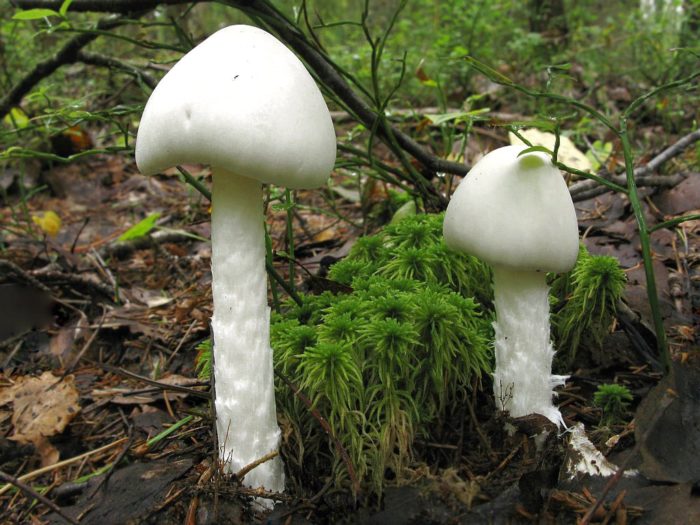
Description of stinky fly agaric
There are several types of poisonous mushrooms in the forests, which retain toxic substances after cooking. The most common of them is the pale toadstool. But no less toxic is a relative of the pale toadstool - the smelly fly agaric, or the white toadstool (amanita virosa).
Have this mushroom has a snow-white hat ovoid, covered with a common white hat together with a small leg. In an adult mushroom, the cap takes on the shape of a bell with a curled edge. Often the cap is asymmetrical, slightly sagging on one side. The width of the cap is 6-8 cm. The cap is smooth on top, covered with the remains of a common blanket.
On top of the leg, higher than that of other toadstools, there is a white ring. A tuber-shaped thickening and a large white fringe, which can be hidden in the litter, is located on the bottom of the leg. The leg can be crooked, there are mushrooms with a damaged cap. This mushroom can grow among bushes, in grass.
The pale grebe most often grows in deciduous forests dominated by birches and lindens. It can be found on fertile soils, on sunlit lawns. A white grebe grows in coniferous and mixed forests, on sandy soils, under blueberry bushes, in wet copses. Another difference is that the cap of the pale toadstool has a greenish tint, while that of the fly agaric is pure white. In appearance, it resembles a pale toadstool, but the smelly fly agaric has a pungent unpleasant odor.

Virulence
The toxicity of the fungus is high, the spores are toxic and dangerous, if they are carried by the wind, they can get on the berries and mushrooms growing nearby. Gathering berries and mushrooms next to the fly agaric, despite their beneficial properties, is dangerous. The toxins contained in the fly agaric are not destroyed during cooking.The danger of poisoning with this fungus is that the clinical picture of intoxication does not appear immediately, but after a few hours.
During this period, irreversible phenomena begin in the body, and the treatment time is missed. Therefore, in many cases, therapy is ineffective, and often the poisoning is fatal.
Mortality from white toadstool poisoning is less than from pale toadstool; its pungent smell scares away mushroom pickers. Toadstool contains the following toxins: virosine, amanitin, etc. Of all the fly agaric species, this fetid white mushroom is the most poisonous and leads to severe poisoning. Signs of poisoning to an insignificant extent appear after half an hour, but a clear manifestation of symptoms occurs after 5-6 hours.

A person experiences the following symptoms:
- headache;
- nausea;
- vomiting;
- diarrhea;
- sharp abdominal pain;
- sweating;
- salivation;
- convulsions;
- excitation;
- hallucinations.
Death in case of poisoning is observed in 50% of cases. A person who has poisoned with fly agaric needs urgent medical attention: he needs to rinse his stomach, take sorbents, do cleansing enemas and drink plenty of water.

Spread of white toadstools
Toadstool grows throughout our country. If the weather is good and there is a lot of warmth and moisture in the forests, then you can see toadstool in April. It grows in coniferous and deciduous moist forests, swamps, sandy soils where moss grows. The smelly fly agaric can grow singly and in groups, often found next to a raincoat.
Similarities with other species
The smelly fly agaric is similar in appearance to some edible species. It can be confused with a float, which differs from the fly agaric in a more fragile body. The leg of the float has no ring, it is empty inside, the cap has small stripes along the edges. Also, mushroom pickers can confuse a toadstool with a beautiful volvariella, which is distinguished by the pinkish color of the plates and the fact that it does not have a ring on its leg.
Sometimes mushroom pickers confuse amanita with champignon, which has brownish plates under the cap, there is a ring on the leg, if you break off a piece of pulp, it will darken. Sometimes people cannot distinguish the fly agaric from the porcini mushroom, because they are similar in appearance. The main difference between edible species and toadstools is the absence of a pungent odor.
Let's go to rest together
If you are going to go to rest in these places for mushrooms or fishing or just sunbathe, then invite like-minded people to your company, it is more interesting to relax together.
All posted ads can be viewed in the Travel Book
Alekseevsky forest
A small group of friends | Going to a famous place looking for a company | There are places in the car | We are going to the woods for Alekseevka, today. To see what there is now from the mushrooms, we will stop by the Silver Spring. Join whoever wishes.
Other offers:
Unusual sauces for barbecue and meat
Shurpa, shulum, ukha and other soups on the fire
The best river fish kebab recipes
Delicious and healthy sea fish kebabs
Chopped meat dishes on the grill
Vegetable and mushroom kebabs, grilled vegetables
Grilled chicken dishes
Red fish and sturgeon kebabs
20 most unusual meat kebabs
Original marinades for meat kebabs
20 best shrimp kebabs
The best legendary barbecue and grill sauces
Campfire potato recipes
Lagman, kulesh, stew, pilaf and other dishes in a cauldron
Barbecue of meat on the bone, loin and ribs on the grill
Tourist Saratov, 2018-2020. All rights reserved.


